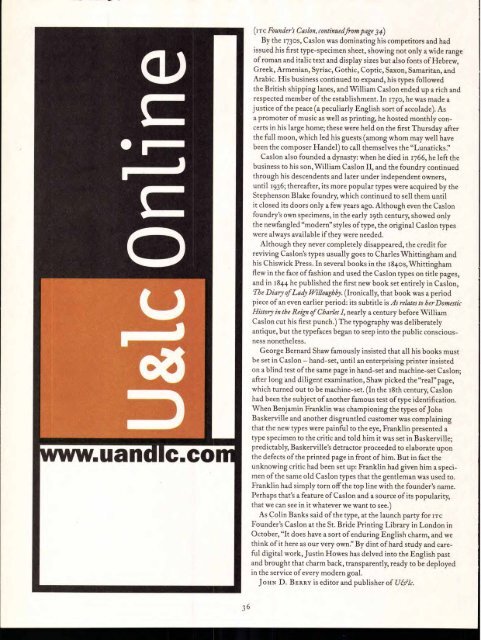You also want an ePaper? Increase the reach of your titles
YUMPU automatically turns print PDFs into web optimized ePapers that Google loves.
3 6<br />
(ITC Founder's Caslon,continuedfrom page 34)<br />
By the 1730s, Caslon was dominating his competitors and had<br />
issued his first type-specimen sheet, showing not only a wide range<br />
of roman and italic text and display sizes but also fonts of Hebrew,<br />
Greek, Armenian, Syriac, Gothic, Coptic, Saxon, Samaritan, and<br />
Arabic. His business continued to expand, his types followed<br />
the British shipping lanes, and William Caslon ended up a rich and<br />
respected member of the establishment. In 1750, he was made a<br />
justice of the peace (a peculiarly English sort of accolade). As<br />
a promoter of music as well as printing, he hosted monthly concerts<br />
in his large home; these were held on the first Thursday after<br />
the full moon, which led his guests (among whom may well have<br />
been the composer Handel) to call themselves the "Lunaticks."<br />
Caslon also founded a dynasty: when he died in 1766, he left the<br />
business to his son, William Caslon II, and the foundry continued<br />
through his descendents and later under independent owners,<br />
until 1936; thereafter, its more popular types were acquired by the<br />
Stephenson Blake foundry, which continued to sell them until<br />
it closed its doors only a few years ago. Although even the Caslon<br />
foundry's own specimens, in the early 19th century, showed only<br />
the newfangled "modern" styles of type, the original Caslon types<br />
were always available if they were needed.<br />
Although they never completely disappeared, the credit for<br />
reviving Caslon's types usually goes to Charles Whittingham and<br />
his Chiswick Press. In several books in the 1840s, Whittingham<br />
flew in the face of fashion and used the Caslon types on title pages,<br />
and in 1844 he published the first new book set entirely in Caslon,<br />
The Diary of Lady Willoughby. (Ironically, that book was a period<br />
piece of an even earlier period: its subtitle is A's relates to berDomestic<br />
History in the Reign of Charles I, nearly a century before William<br />
Caslon cut his first punch.) The typography was deliberately<br />
antique, but the typefaces began to seep into the public consciousness<br />
nonetheless.<br />
George Bernard Shaw famously insisted that all his books must<br />
be set in Caslon — hand-set, until an enterprising printer insisted<br />
on a blind test of the same page in hand-set and machine-set Caslon;<br />
after long and diligent examination, Shaw picked the"real" page,<br />
which turned out to be machine-set. (In the 18th century, Caslon<br />
had been the subject of another famous test of type identification.<br />
When Benjamin Franklin was championing the types of John<br />
Baskerville and another disgruntled customer was complaining<br />
that the new types were painful to the eye, Franklin presented a<br />
type specimen to the critic and told him it was set in Baskerville;<br />
predictably, Baskerville's detractor proceeded to elaborate upon<br />
the defects of the printed page in front of him. But in fact the<br />
unknowing critic had been set up: Franklin had given him a specimen<br />
of the same old Caslon types that the gentleman was used to.<br />
Franklin had simply torn off the top line with the founder's name.<br />
Perhaps that's a feature of Caslon and a source of its popularity,<br />
that we can see in it whatever we want to see.)<br />
As Colin Banks said of the type, at the launch party for ITC<br />
Founder's Caslon at the St. Bride Printing Library in London in<br />
October, "It does have a sort of enduring English charm, and we<br />
think of it here as our very own." By dint of hard study and careful<br />
digital work, Justin Howes has delved into the English past<br />
and brought that charm back, transparently, ready to be deployed<br />
in the service of every modern goal.<br />
Jo HN D. BERRY is editor and publisher of U&/c.

















